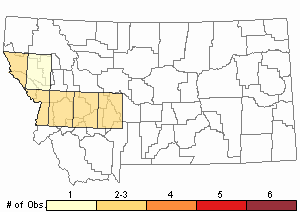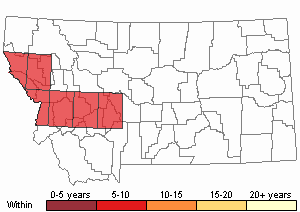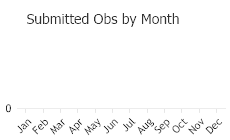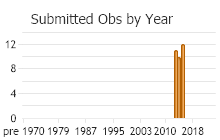View in other NatureServe Network Field Guides
NatureServe
Montana
Utah
Wyoming
Idaho
Wisconsin
British Columbia
South Carolina
Yukon
California
New York
Balsam Woolly Adelgid - Adelges piceae
State Rank Reason (see State Rank above)
Species is not native to Montana and therefore cannot be assigned a status rank (SNA).
General Description
The Balsam Woolly Adelgid is an insect pest of conifer forests. It is a small aphid-like arthropod, 1mm in length that produces a waxy secretion resembling a wool covering its body from which it derives its common name. The species is native to Europe although is thought to have been introduced to North America around 1900 (Ragenovich and Mitchell 2006). Within this introduced range it attacks true firs (Abies spp.), and heavy infestations can cause host death. Impacts to firs within the northwestern US and British Columbia and in the Appalachian Mountains have been severe, and as there is no effective tool to contain or eliminate this species, it has continued to spread.
Diagnostic Characteristics
Adult adelgids are small aphid-like insects. They are small in size and reported to be approximately 1 mm in in length and dark in color (Ragenovich and Mitchell 2006). Adults develop a waxy coating that gives them the characteristic “woolly” appearance. Given the small size, the presence of eggs or larvae are unlikely to be noticed. Effects on the host tree are also diagnostic of adelgid presence. Feeding by this species results in “gouting” or swelling of branch nodes and buds, which over time result in a “fiddle-shape” or top curl (Ragenovich and Mitchell 2006). If the adelgids attack the main burl, needle loss followed by host death within 2-3 years often result.
Range Comments
This species is native to Europe but can be found in several areas of North America including the northeast, northwest, and southeastern United States and southeast and southwest Canada where host species occur. In Montana, the species has been detected across western portions of the state. Most of the mountainous regions of the state have a climate that is predicted to be moderately to highly suitable for this species (Hrinkevich et al. 2016). Agriculture and Bioscience International (CABI)
EDDMapS Species Information EDDMapS Species Information
Observations in Montana Natural Heritage Program Database
Number of Observations: 33
(Click on the following maps and charts to see full sized version)
Map Help and Descriptions
Relative Density

Recency


 (Observations spanning multiple months or years are excluded from time charts)
(Observations spanning multiple months or years are excluded from time charts)
Habitat
The Balsam Woolly Adelgid is a parasite of true fir trees and has generally spread to areas where firs occur in mountainous habitat. The distribution of the species appears to be limited by temperature in the spring and fall, with warm falls and cool wet springs increasing damage to fir stands (Hrinkevich et al. 2016). In Montana, two fir species are present, the Subalpine Fir (Abies lasiocarpa) and Grand Fir (A. grandis). Both firs are know hosts of this pest species (Ragenovich and Mitchell 2006).
Food Habits
See habitat
Ecology
The Balsam Woolly Adelgid may have one, two, three, or four generations per year depending on climate. Populations in North America are exclusively female and reproduce through pathogenesis. Adults deposit around 100-250 amber colored eggs under the waxy/ wolly protective layer. Once the eggs hatch the larvae (crawler) emerge and disperse. Crawlers may move up to 30 m under their own power, but are capable of being blown much futher distances (Global Invasive Species Database 2019). After the crawler has found a suitable site on a host tree, it inserts it’s mouthparts and begins to feed. The crawler transforms to a neosisten, which is the lifestage the species overwinters at as it is resistant to cold temperatures. Once this transformation takes place the individual remains in this position for the remainder of its life. Depending on the season the time spent in the neosisten form can be relatively short (2 weeks) or last from the fall to the spring. Two immature forms follow and adulthood is eventually reached and the life cycle repeated.
Management
There have been attempts to introduce biological controls to manage this species, but to date none have had a population level impact or shown evidence of controlling the spread of this species. In fact, no method to control the effects or manage the spread of this species at the stand or forest level currently exists. Management techniques do exist but are practical for use only on the local or individual scale and include felling and burning infested trees, and spraying trees with insecticide
For information and resources on plant pests and diseases see the USDA's Animal and Plant Health Inspection Service's
Plant Pests and Diseases ProfilesUseful Links:Central and Eastern Montana Invasive Species TeamMontana Invasive Species websiteAquatic Invasive SpeciesStewardship Responsibility
References
- Literature Cited AboveLegend:
 View Online Publication
View Online Publication Global Invasive Species Database. 2019. Adelges piceae. Accessed 12 April 2019. http://www.iucngisd.org/gisd/species.php?sc=226
Global Invasive Species Database. 2019. Adelges piceae. Accessed 12 April 2019. http://www.iucngisd.org/gisd/species.php?sc=226 Hrinkevich, K.H., R.A. Progar, D.C. Shaw. 2016. Climate risk modelling of balsam woolly adelgid damage severity in subalpine fir stands of western North America. PLoS ONE 11(10):e0165094. 11 p.
Hrinkevich, K.H., R.A. Progar, D.C. Shaw. 2016. Climate risk modelling of balsam woolly adelgid damage severity in subalpine fir stands of western North America. PLoS ONE 11(10):e0165094. 11 p. Ragenovich, I.R. and R.G. Mitchell. 2006. Balsam woolly adelgid. Washington, D.C.: USDA Forest Insect and Disease Leaflet 118 (revised). 12 p.
Ragenovich, I.R. and R.G. Mitchell. 2006. Balsam woolly adelgid. Washington, D.C.: USDA Forest Insect and Disease Leaflet 118 (revised). 12 p.
- Web Search Engines for Articles on "Balsam Woolly Adelgid"
- Additional Sources of Information Related to "Insects"





